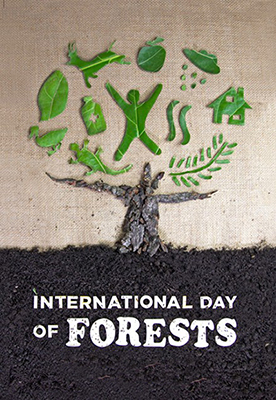It's International Day of Forests
By: Emily Nason
Posted on:03/21/2019Did you know that forests cover one third of the Earth's land mass, performing vital functions around the world? Around 1.6 billion people depend on forests for their livelihoods, medicines, fuel, food and shelter.

Did you know that forests cover one third of the Earth's land mass, performing vital functions around the world? Around 1.6 billion people depend on forests for their livelihoods, medicines, fuel, food and shelter. Forests, their sustainable management and use of resources, are key to combating climate change, and to contributing to the economy and well-being of current and future generations.
Forested watersheds and wetlands supply 75% of the world’s accessible fresh water for domestic, agricultural, industrial and ecological needs and act as natural filters for our air. Forests and trees, celebrated on March 21, the International Day of Forests, are a cornerstone of addressing climate change and achieving sustainable development.
Forests are some of the most vital storehouses of carbon on our planet. Standing forests make a crucial contribution to addressing the impacts of climate change not only by absorbing greenhouse gases but also by building more resilient landscapes through water flow regulation, soil improvement and maintenance for agriculture, protection of coastal communities from extreme events and sea level rise, and migratory corridors for plant and animal species. Improving the management of forests provides opportunities for reducing current and future vulnerability to climate change, while advancing both mitigation and adaptation objectives.
Forests are working to make your quality of life better 24/7 whether you live near woods or hundreds of miles away. If you live near the woods you may see firsthand how forests are beneficial, but if you live in a city you may find yourself wondering how forestland, particularly forestland hours away, benefits you. Perhaps you aren’t an avid hiker, fisherman, nature-watcher, or outdoor enthusiast, and that’s okay!
But it is widely recognized that everyone benefits from undeveloped habitat, like forests or wetlands. These benefits, whether direct or indirect, are referred to as ecosystem services. Ecosystem services are services provided by nature essentially for free that we would otherwise have to pay for. Clean water is one example. Forests filter out pollutants and particulates so that citizens pay less to treat their drinking water. Another way tree-covered landscapes help is by soaking up rainwater, releasing it slowly over time and reducing the amount of runoff that causes rivers and streams to flood. The forest upstream from you may be keeping your cellar dry.
In Maine alone, the forest industry contributes $1.8 million to the state’s economy. The 17 million acres of forests in Maine support the state’s second largest industry, forest products, and significantly contribute to the largest, tourism. The Maine’s North Woods support a diversity and abundance of fish and wildlife found nowhere else in the lower 48 states. The Maine North Woods provide an unbroken expanse of forestland that supports large populations of moose, black bear, loons, lynx, and pine marten. Maine’s forests contain thousands of remote lakes, ponds, rivers, streams, and mountain and wetland environments that support unique natural communities.
Maine’s forestlands:
- Are the last stronghold for native Eastern brook trout
- Provide habitat for the last populations of Atlantic salmon in the U.S.
- Contain the only breeding population of Canada lynx in the East
- Contain breeding habitat yielding a hundred million migratory birds each year
So go out a hug a tree today! Our planet wouldn’t survive without them.
 Sign In
Sign In
 Sign In
Sign In
